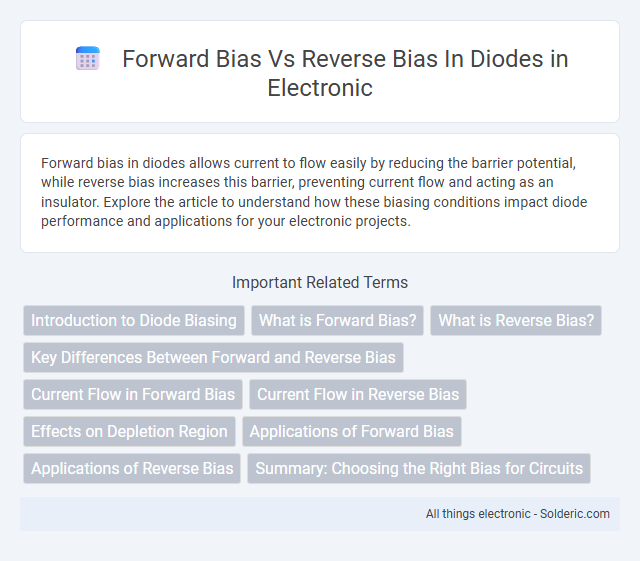Forward bias in diodes allows current to flow easily by reducing the barrier potential, while reverse bias increases this barrier, preventing current flow and acting as an insulator. Explore the article to understand how these biasing conditions impact diode performance and applications for your electronic projects.
Comparison Table
| Aspect | Forward Bias | Reverse Bias |
|---|---|---|
| Definition | Positive voltage applied to the anode relative to the cathode | Positive voltage applied to the cathode relative to the anode |
| Current Flow | Allows current flow (conducts) | Blocks current flow (no conduction except leakage) |
| Depletion Region | Decreases width, enabling charge carriers to cross | Increases width, preventing charge carrier movement |
| Voltage Drop | Typically around 0.7V for silicon diodes | Voltage drop increases up to breakdown voltage |
| Applications | Rectification, switching, signal modulation | Voltage regulation, protection circuits, reverse polarity protection |
| Effect on Charge Carriers | Facilitates recombination of electrons and holes | Prevents recombination, charge carriers are separated |
| Breakdown Behavior | No breakdown under normal conditions | Breaks down if reverse voltage exceeds limit (Zener breakdown or avalanche) |
Introduction to Diode Biasing
Diode biasing controls the direction and magnitude of current flow by applying voltage across its terminals; forward bias occurs when the positive voltage is applied to the anode relative to the cathode, allowing current to pass. Reverse bias is when the positive voltage is on the cathode relative to the anode, preventing current flow except for a negligible leakage current. Proper diode biasing is essential for controlling semiconductor device functionality in circuits such as rectifiers and signal modulators.
What is Forward Bias?
Forward bias in diodes occurs when the positive terminal of the power source is connected to the p-type material and the negative terminal to the n-type material, reducing the barrier potential and allowing current to flow through the diode. This setup decreases the depletion region width, enabling charge carriers to recombine across the junction, which facilitates conduction. Your electronic circuit relies on forward bias conditions to ensure efficient current passage in devices like rectifiers and switches.
What is Reverse Bias?
Reverse bias in diodes occurs when the positive voltage is applied to the cathode and the negative voltage to the anode, creating a high resistance state that prevents current flow. This condition widens the depletion region at the p-n junction, effectively blocking the flow of charge carriers. Reverse bias is essential for controlling leakage current and enabling diodes to function as rectifiers or voltage regulators.
Key Differences Between Forward and Reverse Bias
Forward bias in diodes occurs when the positive terminal of the power supply is connected to the anode and the negative terminal to the cathode, allowing current to flow easily through the diode. Reverse bias happens when the connections are reversed, causing the diode to block current flow by widening the depletion region. Your understanding of semiconductor behavior improves by recognizing that forward bias reduces barrier potential, enabling conduction, while reverse bias increases barrier potential, preventing current except for a minimal leakage current.
Current Flow in Forward Bias
In forward bias, the diode's p-n junction allows significant current flow by reducing the depletion region, enabling charge carriers to cross the junction. Electrons move from the n-type region to the p-type region while holes move in the opposite direction, facilitating conduction. The forward voltage drop, typically around 0.7 volts for silicon diodes, is essential to overcome the barrier potential and initiate current flow.
Current Flow in Reverse Bias
In reverse bias, the diode's p-n junction is polarized such that the depletion region widens, preventing significant current flow through the device. Only a minimal leakage current, often in the nanoampere range, flows due to minority carriers, which is negligible for most practical purposes. Your circuit efficiency relies on this property, as reverse bias effectively blocks current, allowing the diode to function as a one-way valve.
Effects on Depletion Region
Forward bias in diodes decreases the width of the depletion region by allowing charge carriers to recombine across the junction, which reduces the barrier potential and enables current flow. Reverse bias increases the width of the depletion region by pulling charge carriers away from the junction, thereby increasing the barrier potential and preventing current flow. The modulation of the depletion region width directly influences the diode's conductivity and switching behavior.
Applications of Forward Bias
Forward bias in diodes allows current to flow easily, making it essential for rectifiers in power supplies that convert AC to DC. This bias mode is crucial in LED lighting, enabling light emission when the diode is forward biased. Your electronic devices rely on this property for efficient voltage regulation and signal demodulation in communication systems.
Applications of Reverse Bias
Reverse bias in diodes is predominantly utilized in applications such as voltage regulation through Zener diodes, where it stabilizes voltage by allowing breakdown at precise voltages. It also plays a critical role in photodiodes and solar cells by enabling the depletion region to widen, which enhances sensitivity to light and improves efficiency. Furthermore, reverse bias is essential in varactor diodes used for tuning circuits in RF design, exploiting the variable capacitance under different reverse voltages.
Summary: Choosing the Right Bias for Circuits
Forward bias allows current to flow through the diode by reducing the barrier potential, making it ideal for signal rectification and voltage regulation in circuits. Reverse bias increases the barrier potential, preventing current flow and is used for blocking or voltage protection applications. Your circuit design depends on whether you need conduction or insulation, making the correct bias choice essential for optimal diode performance.
Forward bias vs reverse bias in diodes Infographic

 solderic.com
solderic.com